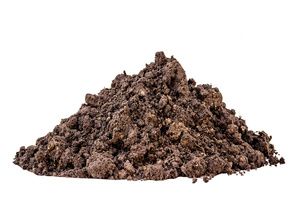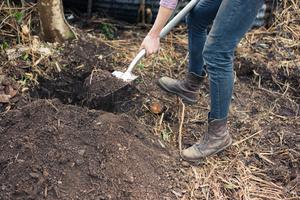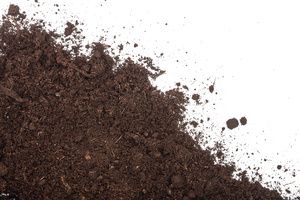When you are embarking on any type of yard or gardening project, you will likely encounter two main categories of soil: screened and unscreened topsoil. Although the names may give you a general idea of what constitutes each type of soil, it is important to understand the differences between them and when one type of soil is preferable over the other.
Many people are drawn to unscreened topsoil because it is more affordable, but it is not suited to every task. Here’s what you need to know about these two soil types and the best ways to use unscreened topsoil.
Understanding Topsoil

First, you need to have a clear idea of what is meant by the term “topsoil“. Some people use it interchangeably with terms like “dirt” and “soil”, but topsoil is actually a very specific variety of soil.
As the name implies, it comes from the uppermost layer of soil in the ground. This is the layer where plants grow because topsoil allows them access to sunlight, water and the nutrients they need to thrive. Topsoil is also the place where microorganisms perform the important task of helping create the perfect environment for healthy plants.
However, it is unwise to assume that the top layer of soil in your yard is ideal for supporting plant growth. Once something is planted in topsoil, the plant may deplete all its nutrients, leaving the soil in poor condition and compromising future planting efforts. Therefore, many people turn to commercially produced topsoil for their gardens – which will normally contain organic material and the right pH levels to support growth.
What Is Unscreened Topsoil?
When shopping for topsoil, you will encounter a wide variety suited for various types of gardening projects, but you must initially decide if you want screened or unscreened topsoil.
Unscreened topsoil is a type of topsoil that is sold in its natural state. As a result, its price is often significantly lower than that of screened topsoil. It may contain a mixture of particle sizes and shapes, which could affect water flow and cause root rot and other types of damage. Therefore, unscreened topsoil is not recommended for vegetable or flower gardens. Moreover, some of the bigger pieces of rocks could damage gardening tools or make it difficult to rake and grade.
Screened topsoil, in contrast, is topsoil that has been passed through mesh to break it down into smaller particles of a more consistent size. Screening also filters out rocks, clumps of dirt, sticks, and anything else present in the soil that is bigger than the screen.
It is typically sold in specific sizes that correspond to the mesh openings used to screen it, such as 3/4 of an inch, allowing gardeners to get the precise size they need for their project. The price tends to rise as the screening size gets smaller.
The fine texture of screened topsoil makes it ideal for allowing nutrients to flow to the roots of plants, and it also facilitates drainage. In addition, it is easier to manipulate and amend uniformly. As a result, it is the ideal choice for growing flowers and vegetables.
What Is Unscreened Topsoil Used For?
Here are the top uses for unscreened topsoil.
Filling Holes

When filling holes in your yard, there is no need for characteristics such as supporting plant growth and supplying nutrients. Therefore, homeowners can save a considerable amount of money by choosing unscreened topsoil to fill holes. The larger rocks that are sometimes found in unscreened topsoil should not be a concern as you will not be working over the soil with a rake or gardening tools.
Leveling
Unscreened topsoil is a good choice for leveling spaces in your yard. There is no need to pay a premium for screened topsoil when you will not be planting anything in it. Unscreened topsoil is a far more affordable option when you need to level out areas of your yard that are unsightly or pose a tripping hazard.
Subsoil Bases
If you are filling a larger or deeper area for gardening, you can save some money by using unscreened topsoil as a subsoil base. Simply spread it across the area in question and then top it with a higher-quality screened topsoil layer to plant your garden. It is particularly good as a subsoil base for root vegetables as it allows the roots to get a good grip and dig in.
You can also use it for planting a new lawn, applying a layer of unscreened topsoil to the area for leveling and filling and then topping it with a layer of screened topsoil in which you will plant your grass seed.
Home Screening

Some people purchase unscreened topsoil to save money and then screen it at home so it will be suitable for gardening. Although this is not practical if you are using a high volume of soil, it is a reasonable task if you have a small garden or a few small gardening beds to fill.
To screen topsoil, you will need a mesh screening dish in your desired size. Place some topsoil into the dish – the precise amount will depend on the size of your dish, so follow the instructions on the product – and shake it over a wheelbarrow or another vessel to collect the screened soil until all of the soil has sieved through the mesh.
When you are finished, you will find debris and rocks in the dish, which you can discard or find another use for in your garden. If you need very fine topsoil, you can screen it again using a smaller mesh screening dish.
Once you have screened the soil, you can amend it with compost or other amendments if desired and use it for the same applications you would use for commercially screened topsoil.
Get in Touch With the Soil Professionals
If you are looking for topsoil or dirt for landscaping and gardening projects, get in touch with the soil experts at Dirt Connections. We can advise you on the best type of soil for the job at hand and arrange delivery of high-quality soil and dirt to your Northern Virginia residential or commercial site.
Summary

Dirt Connections was started with one goal in mind: providing quality residential and commercial construction services to clients on time and on budget. Reach out for more information on how we can support your next project.
For your convenience our estimates are free and by appointment. Call 703-940-9949 for a free estimate today!









































